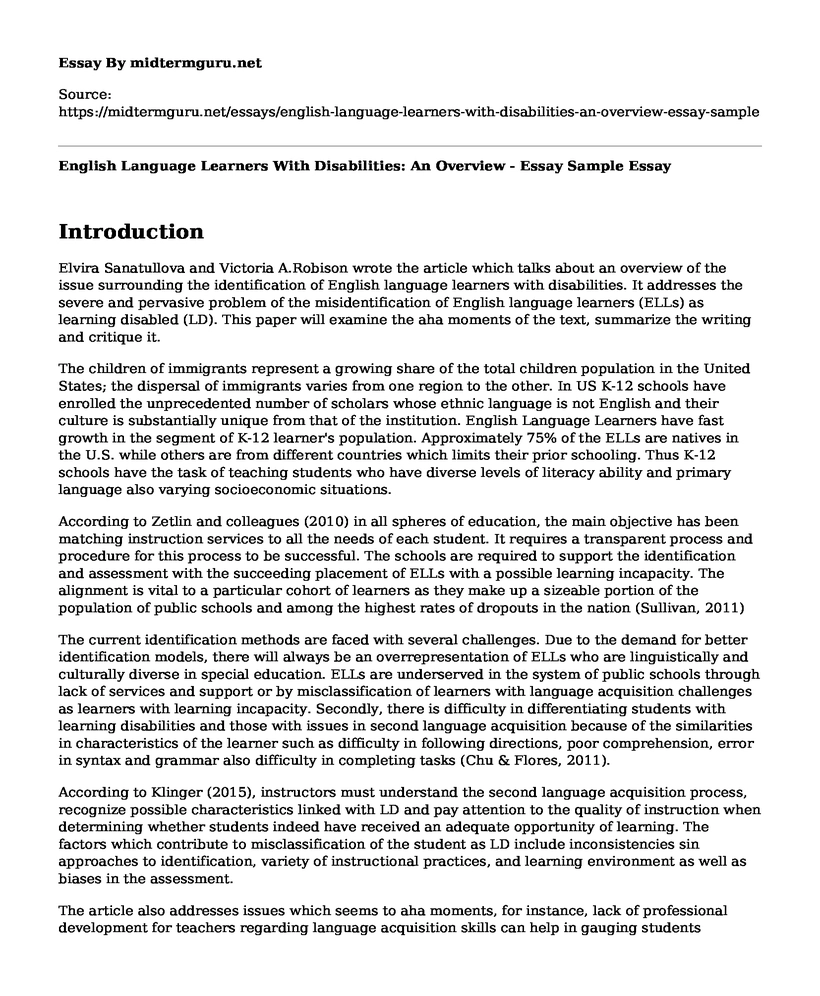Introduction
Elvira Sanatullova and Victoria A.Robison wrote the article which talks about an overview of the issue surrounding the identification of English language learners with disabilities. It addresses the severe and pervasive problem of the misidentification of English language learners (ELLs) as learning disabled (LD). This paper will examine the aha moments of the text, summarize the writing and critique it.
The children of immigrants represent a growing share of the total children population in the United States; the dispersal of immigrants varies from one region to the other. In US K-12 schools have enrolled the unprecedented number of scholars whose ethnic language is not English and their culture is substantially unique from that of the institution. English Language Learners have fast growth in the segment of K-12 learner's population. Approximately 75% of the ELLs are natives in the U.S. while others are from different countries which limits their prior schooling. Thus K-12 schools have the task of teaching students who have diverse levels of literacy ability and primary language also varying socioeconomic situations.
According to Zetlin and colleagues (2010) in all spheres of education, the main objective has been matching instruction services to all the needs of each student. It requires a transparent process and procedure for this process to be successful. The schools are required to support the identification and assessment with the succeeding placement of ELLs with a possible learning incapacity. The alignment is vital to a particular cohort of learners as they make up a sizeable portion of the population of public schools and among the highest rates of dropouts in the nation (Sullivan, 2011)
The current identification methods are faced with several challenges. Due to the demand for better identification models, there will always be an overrepresentation of ELLs who are linguistically and culturally diverse in special education. ELLs are underserved in the system of public schools through lack of services and support or by misclassification of learners with language acquisition challenges as learners with learning incapacity. Secondly, there is difficulty in differentiating students with learning disabilities and those with issues in second language acquisition because of the similarities in characteristics of the learner such as difficulty in following directions, poor comprehension, error in syntax and grammar also difficulty in completing tasks (Chu & Flores, 2011).
According to Klinger (2015), instructors must understand the second language acquisition process, recognize possible characteristics linked with LD and pay attention to the quality of instruction when determining whether students indeed have received an adequate opportunity of learning. The factors which contribute to misclassification of the student as LD include inconsistencies sin approaches to identification, variety of instructional practices, and learning environment as well as biases in the assessment.
The article also addresses issues which seems to aha moments, for instance, lack of professional development for teachers regarding language acquisition skills can help in gauging students response to intervention. Also, the high population of students in public schools today requires more attention to the development of talent. Additionally, frameworks to evaluate and monitor procedures can provide feedback to improve and adjust screening procedures. I tend to agree with Berr et al. (2015) claim from the report that no single method is useful when differentiating between Ells who have a problem in the language acquisition skills and those with a learning disability. The ideas in this article are logically arranged and created an understanding of overrepresentation of ELLs in the classroom.
Conclusion
In conclusion, English language learners have a hard time when acquiring a new language which some people tend to think it is a disability and which is not the case. Learners who have learning disability require an equitable, informed way of learning and become successful in their academics. Several techniques are used in the creation of equality which includes adequate professional development of both individual and general teachers in terms of language acquisition. Also, aligning and clarifying policies at all stages of academics.
References
Burr, E., Haas, E., & Ferriere, K. (2015). Identifying and supporting English learner students with learning disabilities: Key issues in the literature and state practice (REL 2015- 086). Washington, DC: U.S. Department of Education, Institute of Education Sciences, National Center for Education Evaluation and Regional Assistance, Regional Educational Laboratory West. Retrieved from: http://ies.ed.gov/ncee/edlabs.
Chu, S.-Y., & Flores, S. (2011). Assessment of English language learners with learning disabilities. The Clearing House, 84, 244-248.Retrieved from https://www.tandfonline.com/doi/abs/10.1080/00098655.2011.590550
Sullivan, A. L. (2011). Disproportionality in individual education identification and placement of English language learners. Exceptional Children, 77(3), 317-334.Retrieved from https://journals.sagepub.com/doi/abs/10.1177/001440291107700304
Zetlin, A., Beltran, D., Salcido, P., Gonzalez, T., & Reyes, T. (2010). Building a pathway of optimal support for English language learners in special education. Teacher Education and Special Education: The Journal of the Teacher Education Division of the Council for Exceptional Children February, 34, 59-70.Retrieved from https://journals.sagepub.com/doi/abs/10.1177/0888406410380423
Cite this page
English Language Learners With Disabilities: An Overview - Essay Sample. (2023, Feb 09). Retrieved from https://midtermguru.com/essays/english-language-learners-with-disabilities-an-overview-essay-sample
If you are the original author of this essay and no longer wish to have it published on the midtermguru.com website, please click below to request its removal:
- An Extensive Description of Pregnancy and Child Development on Perla Example
- Research Paper on Partnering with ELL Families
- Essay on Critical Incidents in the Classroom: Aggressive Behaviors and Outbursts
- Time Management Strategies for Teachers in South Arabia - Essay Sample
- Conduct of Children: Birth Order & Social Influence in Schools - Research Paper
- Different Language, Different Decisions: A Look at How Language Influences Our Choices - Essay Sample
- Motivating E-Learners: Tips & Strategies for Success - Essay Sample







